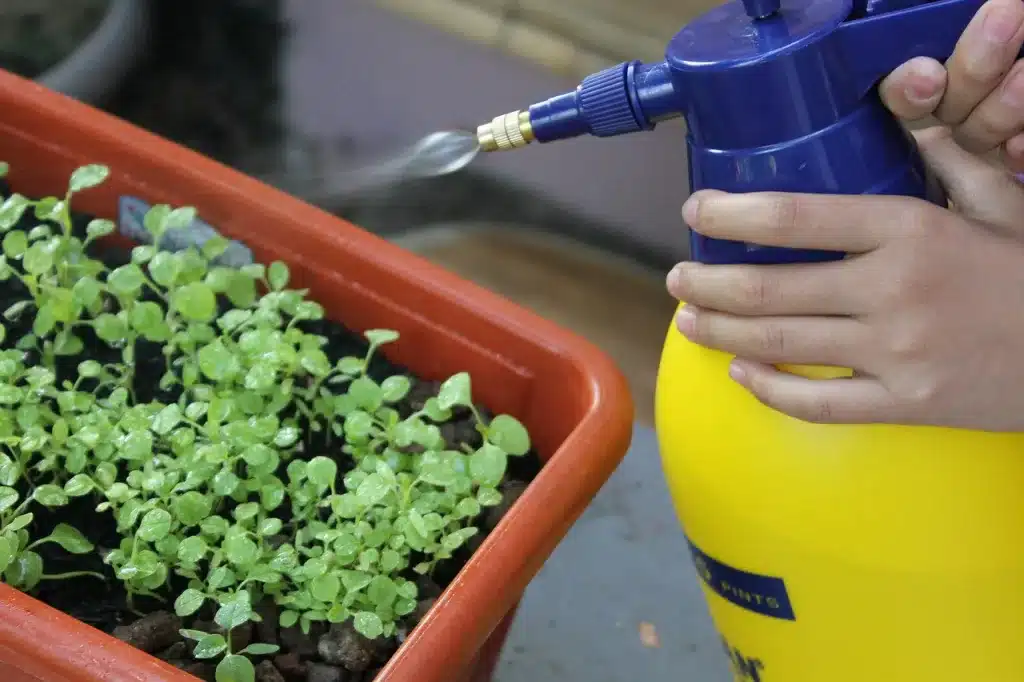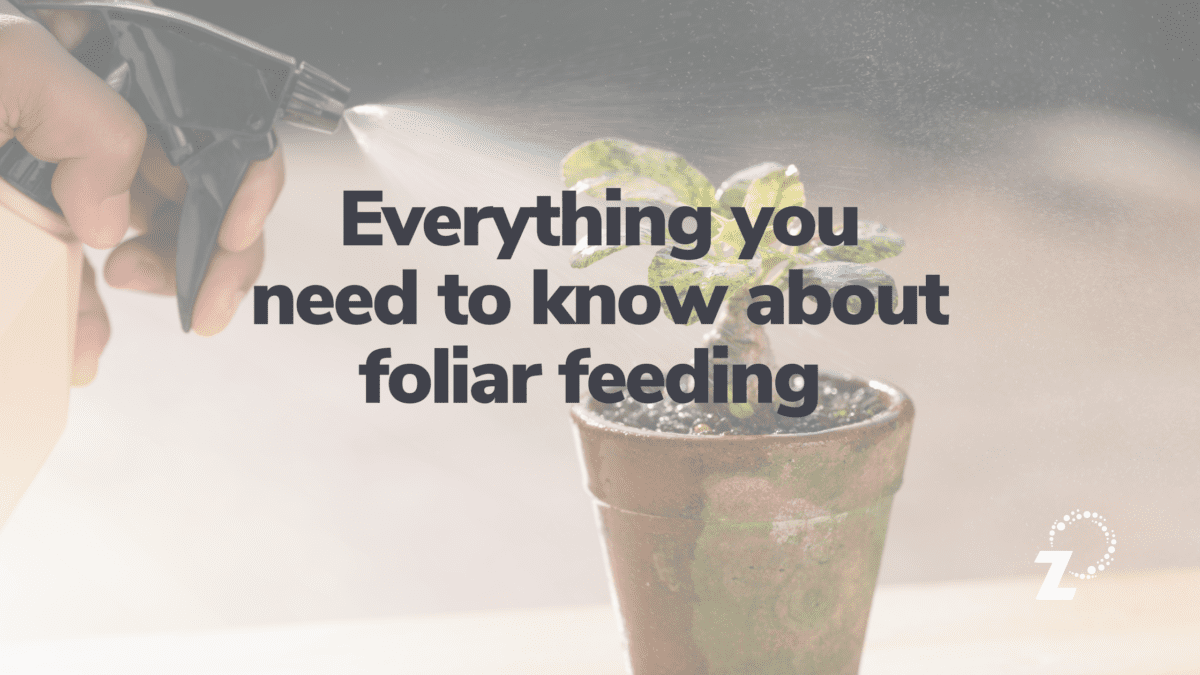An article by agronomic consultant Jim Pingrey printed in the July 2023 issue of the Acres U.S.A. magazine proposes that “soil health is essential for a resilient plant, but we can also ramp up plant resilience and aid in building soil health by applying timely foliar sprays”.
In recent times, foliar feeding has become accepted as an essential aspect of crop production, particularly on horticultural plants. For example, farmers can use foliar feeding to boost a perennial tree with reproductive inputs in a delayed dormant treatment prior to bloom and induce resistance to bloom-time diseases. Although its use is not as widespread in agronomic crops, the multiple benefits of foliar feeding have been well-documented. In-season foliar sprays can also be used to increase photosynthetic efficiency and increase the sugars within the plant. But, like any input, achieving the maximum benefit from foliar spraying requires a tailored approach.

What is foliar feeding?
Foliar feeding is the application of essential plant nutrients to above-ground parts of the plant. This is done by spraying soluble minerals as a fine mist on the leaves. With foliar feeding, nutrients are generally absorbed more effectively than with soil-administered fertilising.
Did you know?
Foliar feeding was first documented over 100 years ago, when farmers used iron sprays to correct leaf chlorosis.
The top 10 benefits of foliar feeding
A significant benefit from foliar applications of essential nutrients, amino acids and metabolites, is the increased rate of photosynthesis, which includes a greater volume of exudates via the root system, stimulating microbes associated with solubilising soil nutrients and making them available to the plant. Studies have shown that foliar feeding results in between 8 and 20 times more absorption.
- Efficiency: Foliar fertilisation is less dependent on the soil and doesn’t rely on specific soil conditions. It circumvents problems such as dilution, penetration and fixation.
- Stimulates root development: Foliar nutrition has been shown to improve root growth, enabling the plant to absorb more water and nutrients.
- Practicality: In some instances, foliar sprays are the only practical means of correction and control.
- Eliminates common deficiencies: Foliar applications compensate for the erratic and irregular soil absorption, which exacerbates plant deficiencies.
- Rapid intervention: Foliar inputs get to work much faster than nutrition via soil applications. Nutrients applied externally are absorbed almost immediately.
- Control the growth of your crop: Applying certain elements at specific moments allows you to stimulate certain processes in the plant and take control of your crop development.
- Increase plant resistance: Well-fed plants are healthier, stronger and more resistant to disease.
- Improve the quality of your yield: Ensure that your crops get the right nutrients at the right time, independent of their availability in the soil.
- Save time: Many foliar applications offer more than one specific nutrient or benefit, allowing you to effectively input multiple applications at once.
- Save money: More efficient nutrition for the plant with foliar fertilisation reduces the need for soil fertilisation, when soil conditions are not conducive to nutrient uptake.
Despite the numerous benefits of foliar feeding, it is far from a one-size-fits-all approach. For example, there are many documented instances in which negative results from foliar fertilisation have been reported in crops such as soybeans, corn, wheat, oats and alfalfa.
The most favourable results from foliar feeding are likely to occur in plants with a good leaf area to allow for maximum nutrient uptake.
When is the best time to foliar feed?
The best time for foliar spraying: 06:00 – 08:00 in the morning or 18:00 – 20:00 at night (when the humidity is high).
Deriving the maximum benefit from foliar feeding relies on proper timing of application, which includes both the plant’s stage in the growth cycle, as well as meteorological conditions. Here are some tips to help you determine when to foliar feed:
- Proper growth stage: Foliar applications should be timed to meet the current nutritional needs of the plant during its development. For this reason, it’s important to monitor the crop’s growth stage frequently. For example, foliar feeding can be more effective on agronomic crops when they are flowering and fruit setting.
- Proper crop condition: The best responses to foliar feeding are seen in crops that are nutritionally sound due to better tissue quality that allows for maximum nutrient absorption and translocation.
- Proper meteorological conditions: Time of day, temperature, humidity and wind speed will influence the physical and biological aspects of foliar application. For example, calm, warm, moist conditions favour high plant tissue permeability, and thus nutrient absorption.
Other factors to take into consideration when evaluating the potential benefits of foliar fertilisation in specific circumstances include:
Crop type
- Leaf area and morphology
- Soil moisture
- Soil nutrient level
- The nature of the applied substance
When to foliar feed
When building a foliar application protocol, it’s important to stack the proper nutrients to create what you want.
Do you need to boost the calcium in your soil? Try Nanocal.
Do you want to build better brix levels? Use Sea Brix.
Do you need a foliar feed designed specifically for macadamia trees? Try K-Mac.

Do your plants look anything like this? They may be deficient in key nutrients. You may need MicrosZ, a foliar spray that contains key trace elements like zinc and manganese.
It’s important to note that foliar applications are a useful mechanism to maximise yield and quality but must not be regarded as a substitute for soil-applied fertiliser, the requirement of which would be determined from a soil sample.
Top tips for optimal foliar spraying
- Ensure Proper Mixing: When adding another product besides nutrition, make sure it mixes well without precipitation at the desired pH.
- Optimal pH Range: Maintain a solution pH between 5.5 and 6.5 for increased absorption. Lower the pH with apple vinegar or raise it with bicarbonate of soda as needed.
- Optimise Absorption Timing: Apply foliar sprays when the plant is actively growing, especially just before flowering, at veraison, and just before ripening. These stages offer the best absorption opportunities.
- Time of Day Matters: Spray early morning, even if dew is present, when you have ample time for the spray to dry without any possibility of rain or overhead irrigation. Longer drying time enhances absorption.
- Pre-Bloom Spraying: It’s acceptable to spray perennial crops before the foliage emerges, especially for plants that bloom before vegetative growth. The larger openings in the wood allow better penetration.
- Consider Lunar Timing: If possible, adjust your spray timing to coincide with five days leading up to a full moon, as this is when maximum sap movement occurs in the aboveground portion of the plant. For fertigation, start five days prior to a new moon when most energy moves to the roots.
- Use Humic or Fulvic Acids: These substances can optimise nutrient uptake. Humic acid pairs well with nitrogen applications, while fulvic acid is suitable for lower-pH mixes, offering great buffering capabilities and improved responses when added to the spray.
- Incorporate Immune Enhancers: Don’t hesitate to use products that enhance the plant’s immune response, such as kelp, silica, triacontanol, chitinase, and certain bacillus strains of bacteria.
- Use Natural Chelators: Opt for natural chelators like fulvic acid, amino acids, and lignosulfonates, and avoid using EDTA chelators. EDTA chelators are not easily broken down by the plant or soil and can negatively impact the plant’s energy and nutrient balance.
- Spray as Fine Mist: Foliar feeding is best absorbed when sprayed as a very fine mist under high pressure. Smaller droplet sizes are more effective, as the tiny hairs around each stomata attract the nutrients within each droplet.
- Use Good Quality Water: Avoid water with high sodium (Na) or hard water (high calcium) content, as it can cause absorption problems.
- Add Surfactant: Incorporate a surfactant in the spray solution to help it adhere better to the leaf surface, increasing absorption by preventing water drops from forming balls that are difficult to absorb.
Foliar feeding solutions from Zylem
Foliar feeding is rapidly being standardised as insurance against specific plant deficiencies and the hazards of unpredictable weather. In some cases, it is the only practical means to supply specific nutrients to a plant. All of Zylem’s biological soil amendments and nutrition products can be foliar-applied where appropriate. Feel free to reach out to us to learn about the best applications for your unique circumstances. Learn more about our products.

About the Author: Justin Platt
Justin is the Founder & CEO of Zylem and RegenZ. Justin has a BSc in Plant Pathology and Botany from UKZN. He has been involved in the agricultural services industry since graduating in 1979. Justin has a passion for regenerative agriculture.

